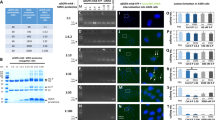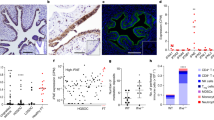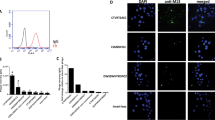Abstract
The α-folate receptor (FR) is selectively overexpressed in 90% of nonmucinous ovarian carcinomas, whereas no expression is detectable in normal ovarian surface epithelium (OSE). Indirect evidence suggests that FR expression is associated with tumor progression and affects cell proliferation. To evaluate better the role of FR, we developed an approach based on intracellular expression of single-chain (sc) antibodies (intrabody) to downmodulate membrane expression of FR in ovary cancer cells. IGROV-1 and SKOV3 ovarian carcinoma cell lines were transfected with an anti-FR intrabody. Transfectants and parental cells were tested for FR, integrins and anti-FR intrabody expression by fluorescence-activated cell sorting (FACS), reverse transcription and polymerase chain reaction (RT-PCR) and/or immunoblotting. Cell growth characteristics and adhesion properties were evaluated in liquid, semisolid and organotypic cultures. The anti-FR scFv inhibited FR expression from 60 to 99%. At physiological concentrations of folate, proliferation varied directly as a function of FR expression. FR downmodulation was accompanied by reduced colony-forming ability in soft agar, morphological change of the cells, significant enhanced adhesion to laminin or Matrigel, a two- to three-fold increase in α6β4 integrin expression, and a marked reduction in laminin production. In three-dimensional organotypic cultures, anti-FR intrabody-transfected IGROV1 cells grew as a single-ordered layer, reminiscent of normal OSE growth in vivo. In conclusion, the anti-FR intrabody reverses the transformed phenotype in ovary cancer cells and may provide an efficient means to inhibit selectively the growth of these cells.
This is a preview of subscription content, access via your institution
Access options
Subscribe to this journal
Receive 12 print issues and online access
$259.00 per year
only $21.58 per issue
Buy this article
- Purchase on Springer Link
- Instant access to full article PDF
Prices may be subject to local taxes which are calculated during checkout




Similar content being viewed by others
References
Glennie MJ, Johnson PW . Clinical trials of antibody therapy. Immunol Today 2000; 21: 403–410.
Marasco WA, Haseltine WA, Chen SY . Design, intracellular expression, and activity of a human anti-human immunodeficiency virus type 1 gp120 single-chain antibody. Proc Natl Acad Sci USA 1993; 90: 7889–7893.
Curiel DT . Targeted tumor cytotoxicity mediated by intracellular single-chain anti-oncogene antibodies. Adv Pharmacol 1997; 40: 51–84.
Pichè A, Rancourt C . A role for intracellular immunization in chemosensitization of tumor cells? Gene Ther 1999; 6: 1202–1209.
Wang-Johanning F et al. Intracellular expression of a single-chain antibody directed against human papillomavirus type 16 E7 oncoprotein achieves targeted antineoplastic effects. Cancer Res 1998; 58: 1893–1900.
Cochet O et al. Intracellular expression of an antibody fragment-neutralizing p21 Ras promotes tumor regression. Cancer Res 1998; 58: 1170–1176.
Marasco WA et al. Intracellular antibodies against HIV-1 envelope protein for AIDS gene therapy. Hum Gene Ther 1998; 9: 1627–1642.
Alvarez RD et al. A cancer gene therapy approach utilizing an anti-erbB-2 single-chain antibody-encoding adenovirus (AD21): a phase I trial. Clin Cancer Res 2000; 6: 3081–3087.
Miotti S et al. Characterization of human ovarian carcinoma-associated antigens defined by novel monoclonal antibodies with tumor-restricted specificity. Int J Cancer 1987; 39: 297–303.
Luhrs CA, Slomiemy BL . A human membrane-associated folate binding protein is anchored by a glycosyl-phosphatidylinositol tail. J Biol Chem 1989; 264: 21446–21449.
Lacey SW et al. Complementary DNA for the folate binding protein correctly predicts anchoring to the membrane by glycosyl-phosphatidylinositol. J Clin Invest 1989; 84: 715–720.
Alberti S et al. The Ca-MOv18 molecule, a cell-surface marker of human ovarian carcinomas, is anchored to the cell membrane by phosphatidylinositol. Biochem Biophys Res Commun 1990; 171: 1051–1055.
Toffoli G et al. Overexpression of folate binding protein in ovarian cancers. Int J Cancer 1997; 74: 193–198.
Ross JF, Chaudhuri PK, Ratnam M . Differential regulation of folate receptor isoforms in normal and malignant tissues in vivo and in established cell lines. Physiologic and clinical implications. Cancer 1994; 73: 2432–2443.
Veggian R et al. Immunohistochemical reactivity of a monoclonal antibody prepared against human ovarian carcinoma on normal and pathological female genital tissues. Tumori 1989; 75: 510–513.
Boerman OC et al. Comparative immunohistochemical study of four monoclonal antibodies directed against ovarian carcinoma-associated antigens. Int J Gynecol Pathol 1991; 10: 15–25.
Mantovani L et al. Folate binding protein distribution in normal tissues and biological fluids from ovarian carcinoma patients as detected by the monoclonal antibodies MOv18 and MOv19. Eur J Cancer 1994; 30A: 363–369.
Bagnoli M et al. Downmodulation of caveolin-1 expression in human ovarian carcinoma is directly related to α-folate receptor overexpression. Oncogene 2000; 19: 4754–4763.
Miotti S et al. Interaction of folate receptor with signaling molecules lyn and Gα13 in detergent-resistant complexes from the ovary carcinoma cell line IGROV1. J Cell Sci 2000; 113: 349–357.
Canevari S et al. Regression of advanced ovarian carcinoma by intraperitoneal treatment with autologous T-lymphocytes retargeted by a bispecific monoclonal antibody. J Natl Cancer Inst 1995; 87: 1463–1469.
Crippa F et al. Single dose intraperitoneal radioimmunotherapy with the murine monoclonal antibody 131I-MOv18: clinical results in patients with minimal residual disease of ovarian cancer. Eur J Cancer 1995; 31A: 686–690.
Beerli RR, Wels W, Hynes NE . Intracellular expression of single chain antibodies reverts ErbB-2 transformation. J Biol Chem 1994; 269: 23931–23936.
Bottero F et al. Gene transfection and expression of the ovarian carcinoma marker folate binding protein on NIH/3T3 cells increases cell growth in vitro and in vivo. Cancer Res 1993; 53: 5791–5796.
Schlegel A, Lisanti MP . The caveolin triad: caveolae biogenesis, cholesterol trafficking, and signal transduction. Cytokine Growth Factor Rev 2001; 12: 41–51.
Engelman JA et al. Recombinant expression of caveolin-1 in oncogenically transformed cells abrogates anchorage-independent growth. J Biol Chem 1997; 272: 16374–16381.
Skubitz AP et al. Expression of α6 and β4 integrins in serous ovarian carcinoma correlates with expression of the basement membrane protein laminin. Am J Pathol 1996; 148: 1445–1461.
Byers LJ et al. Increased levels of laminin in ascitic fluid of patients with ovarian cancer. Cancer Lett 1995; 88: 67–72.
Haynes BF, Liao HX, Patton KL . The transmembrane hyaluronate receptor (CD44): multiple functions, multiple forms. Cancer Cells 1991; 3: 347–350.
Giannelli G et al. Induction of cell migration by matrix metalloprotease-2 cleavage of laminin-5. Science 1997; 277: 225–228.
Guruswamy S et al. Effects of retinoids on cancerous phenotype and apoptosis in organotypic cultures of ovarian carcinoma. J Natl Cancer Inst 2001; 93: 516–525.
Gregoire L et al. Organotypic culture of human ovarian surface epithelial cells: a potential model for ovarian carcinogenesis. In Vitro Cell Dev Biol Anim 1998; 34: 636–639.
Boudreau N, Bissell MJ . Extracellular matrix signaling: integration of form and function in normal and malignant cells. Curr Opin Cell Biol 1998; 10: 640–646.
Bénard J et al. Characterization of a human ovarian adenocarcinoma line, IGROV1, in tissue culture and in nude mice. Cancer Res 1985; 45: 4970–4979.
Miotti S et al. Growth of ovary carcinoma cell lines at physiological folate concentration: effect on folate binding protein expression in vitro and in vivo. Int J Cancer 1995; 63: 395–401.
Kruk PA, Maines-Bandiera SL, Auersperg N . A simplified method to culture human ovarian surface epithelium. Lab Invest 1990; 63: 132–136.
Coney LR et al. Cloning of a tumor-associated antigen: MOv18 and MOv19 antibodies recognize a folate-binding protein. Cancer Res 1991; 51: 6125–6132.
Tosi E et al. Anti-tumor efficacy of an anti-epidermal growth factor receptor monoclonal antibody and its F(ab')2 fragment against high- and low-EGFR-expressing carcinomas in nude mice. Int J Cancer 1995; 62: 643–650.
Centis F et al. p185 HER2/neu epitope mapping with murine monoclonal antibodies. Hybridoma 1992; 11: 267–276.
Munro S, Pelham HR . An Hsp70-like protein in the ER: identity with the 78kd glucose regulated protein and immunoglobulin heavy chain binding protein. Cell 1986; 46: 291–300.
Figini M et al. Panning phage antibody libraries on cells: isolation of human Fab fragments against ovarian carcinoma using guided selection. Cancer Res 1998; 58: 991–996.
Munro S, Pelham HR . A C-terminal signal prevents secretion of luminal ER proteins. Cell 1987; 48: 899–907.
Persic L et al. Targeting vectors for intracellular immunisation. Gene 1997; 187: 1–8.
Gospodarowicz D, Barnes DW, Sirbasku DA, Stao GH (eds) Supplements and substrata. In: Methods for Preparation of Media. Liss A.R: New York, 1984; pp 275–293.
Jacobs N et al. Organotypic culture of HPV-transformed keratinocytes: a model for testing lymphocyte infiltration of (pre)neoplastic lesions of the uterine cervix. Virchows Arch 1998; 432: 323–330.
Author information
Authors and Affiliations
Rights and permissions
About this article
Cite this article
Figini, M., Ferri, R., Mezzanzanica, D. et al. Reversion of transformed phenotype in ovarian cancer cells by intracellular expression of anti folate receptor antibodies. Gene Ther 10, 1018–1025 (2003). https://doi.org/10.1038/sj.gt.3301962
Received:
Accepted:
Published:
Issue Date:
DOI: https://doi.org/10.1038/sj.gt.3301962
Keywords
This article is cited by
-
Exploiting the folate receptor α in oncology
Nature Reviews Clinical Oncology (2020)
-
Applying Antibodies Inside Cells: Principles and Recent Advances in Neurobiology, Virology and Oncology
BioDrugs (2020)
-
Maternal folic acid supplementation reduces the severity of cleft palate in Tgf-β3 null mutant mice
Pediatric Research (2019)
-
FOLR1 increases sensitivity to cisplatin treatment in ovarian cancer cells
Journal of Ovarian Research (2018)



